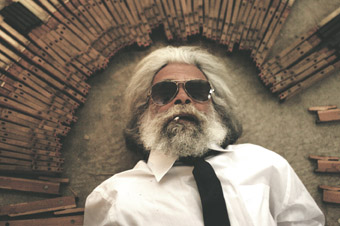jack charles, hybrid lives
lucille paterson: amiel courtin-wilson’s bastardy

Jack Charles, Bastardy
JACK CHARLES OCCUPIES A NUMBER OF CONFLICTING IDENTITIES: ACTOR, HOMELESS PERSON, HEROIN ADDICT, HOMOSEXUAL, EX-CON, ACTIVIST AND MEMBER OF THE STOLEN GENERATION. HE ADDRESSES ALL OF THESE IN AMIEL COURTIN-WILSON’S DOCUMENTARY, BASTARDY, WHICH FOLLOWS THE INDIGENOUS ACTOR OVER NINE YEARS, TELLING STORIES OF PAST AND PRESENT EXPERIENCES.
When we first meet Charles, he is a homeless heroin addict. We watch in close-up as he injects. He addresses the camera moments after, confidently telling the director that if he hadn’t just witnessed this, he wouldn’t be able to tell that Charles was high. This scene immediately conveys the contrast between Charles’ bearing—his affected English accent, self-awareness, good looks and charisma—and his plight. This enables him to address the mainstream from the position of a fringe-dweller.
Courtin-Wilson, who directed the awarding-winning documentaries Chasing Buddha (2000) and Islands (2000) and whose short fiction CICADA (2009) screened at Cannes this year, again reveals his skills as a filmmaker in this intricately constructed documentary. While the film is visually and narratively fragmented, repeated visual motifs and the soundtrack, featuring several tracks by CocoRosie, bind the film. For example there are numerous shots of Charles walking the streets or travelling across the city by tram or taxi. Bastardy is also interspersed with atmospheric Super 8 footage of inner-Melbourne streetscapes, providing pause between segments of the film and complementing the repeated visual motif of Charles’ movement through the streets.
Bastardy reveals different aspects of Charles’ life and personality gradually. The film comprises archival footage, photographs and recreations as well as footage from the present. This includes Charles addressing the camera directly and guiding Courtin-Wilson to places around Melbourne alongside scenes such as his release from prison. Consequently a narrative about Charles’ life during the making of the documentary emerges next to an exploration of his past.
There is a strong focus on Charles’ physical surroundings in Bastardy, providing insight into his life and allowing the audience to view Melbourne from an alternative perspective. At the beginning of the film, when Charles is living on the streets we see where he sleeps and shoots up. In some of the most entertaining moments of the film, we see him guide Courtin-Wilson around the exterior of houses he burgled in the wealthy suburb of Kew. Later, we see him inside his housing commission flat, after returning from prison, attending to domestic chores and taking pleasure in finding that everything is as he left it.
In an interview with the ABC, Amiel Courtin-Wilson said he initially wanted to focus on Charles’ early life, filming interviews with friends and colleagues. In the end, these did not make it into the film; instead Charles tells his own stories. The focus on his present state compels the audience to consider the ongoing impact of Australia’s traumatic colonial history. As a member of the Stolen Generation Charles speaks of the impact of the abuse he suffered in the boys’ homes where he grew up and of finding family members later in life.
Bastardy also addresses Charles’ acting career, which he managed to maintain despite frequent prison sentences, drugs and industry attitudes to Aboriginal actors. Beginning his career in theatre, he co-founded the first Aboriginal theatre, Nindethana, with Bob Maza in 1971. Bastardy includes archival footage of Charles acting on stage and in films, including The Chant of Jimmie Blacksmith (Fred Schepisi 1978), Bedevil (Tracey Moffat 1993) and Tom White (Alkinos Tsilimidos 2004). After the screening of Bastardy at Melbourne’s Blak Nite Cinema, actor Aaron Pederson spoke of the obstacles that are placed in the way of Indigenous actors to this day, and of the need for mainstream film and television to be braver in their casting.
While Bastardy doesn’t flinch from depicting the hardships of Charles’ life or the darker sides of his personality, it’s an enjoyable film. With his indomitable spirit and wit, Charles is a pleasure to watch and Courtin-Wilson weaves together themes, incidents and stories engagingly and provocatively. Jack Charles’ experiences raise crucial issues about the ongoing impact of the Stolen Generation and racism in Australia, but the man’s history is also important because of his contribution to mainstream and Indigenous culture though his activism and a long acting career.
Bastardy, Siren Visual DVD: screening Palace Cinemas; winner Best Documentary Jury Prize, 2008 FCCA (Film Critics Circle of Australia) Awards.
Bastardy, director Amiel Courtin-Wilson, director of photography Germain McMicking, producer Phillipa Campey, Film Camp, editors Jack Hutchings, Bill Murphy, Richard Lowenstein, composer Steve Benwell, 2008, 83mins; www.bastardydocumentary.com
RealTime issue #91 June-July 2009 pg. 24






